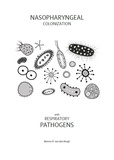Nasopharyngeal colonization with respiratory pathogens

Bergh, Menno van den
- Promoter:
- Prof.dr. E.A.M. (Lieke) Sanders
- Co-promoter:
- Dr. R.H. (Reinier) Veenhoven
- Research group:
- Sanders
- Date:
- April 19, 2013
- Time:
- 12:45 h
Summary
Respiratory (otitis media, pneumonia) and invasive (sepsis, meningitis) infections cause substantial morbidity and mortality worldwide. The World Health Organization estimates that every year one million children under the age of five die of pneumonia, mainly in developing countries. Elderly are another risk group, particularly vulnerable to community-acquired pneumonia. Leading bacterial pathogens in these infections are Streptococcus pneumoniae and nontypeale Haemophilus influenzae (NTHi). These bacteria, however, are also part of the normal nasopharyngeal microbial ecosystem and present in 50-70% of healthy infants and toddlers. They are in continuous interaction with viruses, other symbionts and pathobionts, and the host’s (maturing) immune system. Disturbances of local ecosystem dynamics, through a viral infection or recent acquisition of a bacterial strain, may trigger overgrowth, spread and invasion of S. pneumoniae or NTHi, causing disease. In this thesis, we have focused on (1) results of a randomized controlled trial evaluating effects of the 10-valent pneumococcal nontypeable Haemophilus influenzae protein D-conjugate vaccine (PHiD-CV) on nasopharyngeal bacterial colonization, (2) immunogenicity, safety and reactogenicity of PHiD-CV when administered concomitantly with other pediatric vaccines, (3) associations among viral and bacterial pathogens in the nasopharynx of healthy children, (4) sampling methods for detecting bacterial pathogens in children with an upper respiratory tract infection, and (5) nasopharyngeal S. pneumoniae colonization in elderly. In the randomized trial in 780 healthy infants, we found that PHiD-CV (using NTHi-derived protein D as a carrier protein) had no differential impact on nasopharyngeal NTHi colonization or its density compared to 7vCRM (a non-active control). This implies that no herd effect for H. influenzae is to be expected. For S. pneumoniae, impact on colonization appeared similar to the currently used 7-valent vaccine. In addition, coadministration of PHiD-CV and DTPa-IPV-Hib in a 3+1-dose schedule was shown to be immunogenic and well-tolerated. Nonetheless, continuous immune surveillance is important when new vaccines are introduced into existing immunization schedules, especially since sero-epidemiology may change with waning immunity. Investigating the nasopharyngeal ecosystem in 1000 samples from healthy children, we found that respiratory viruses were abundantly present with at least one virus present in 70% of 6- to 24-month-old children. In addition, there were distinct associations among several respiratory viruses and bacteria. If and how these associations relate to disease warrants further investigation. Sampling with a deep nasopharyngeal swab is the gold standard to detect bacterial pathogens such as S. pneumoniae and H. influenzae. In a cross-sectional study, however, we demonstrated that in children with an upper respiratory tract infection, these bacteria can be reliably detected in a sample collected by simply wiping/blowing the nose into a paper tissue. Although elderly have pneumococcal disease incidence rates equalling those of infants, nasopharyngeal S. pneumoniae colonization appeared to be low when measured with conventional culture methods. In a study in 330 asymptomatic community-dwelling elderly, we found however that a quatitative polymerase chain reaction assay substantially increases detection of S. pneumoniae. Conventional culture largely underestimates pneumococcal colonization in older adults. Molecular techniques are essential when evaluating new vaccination strategies in this risk group.